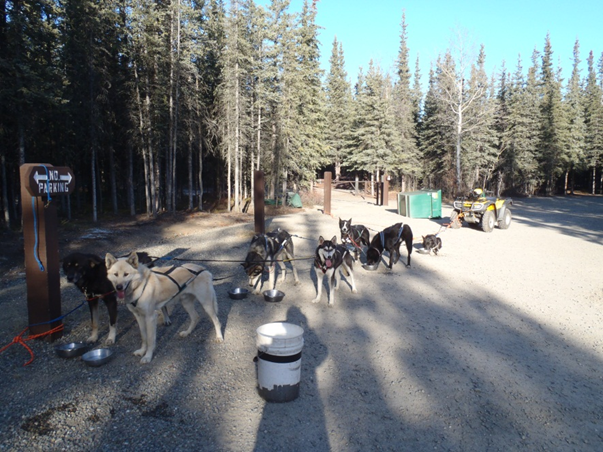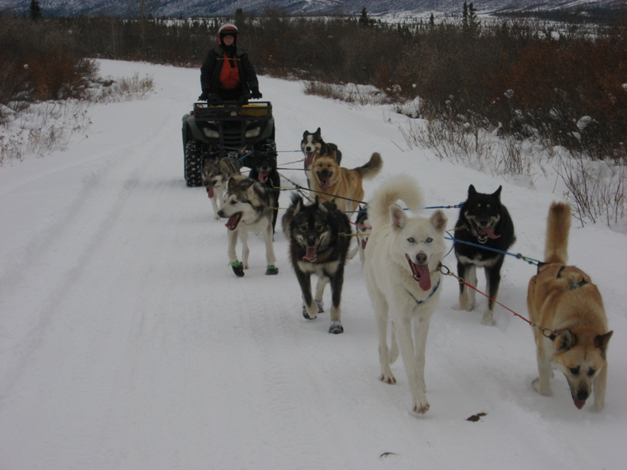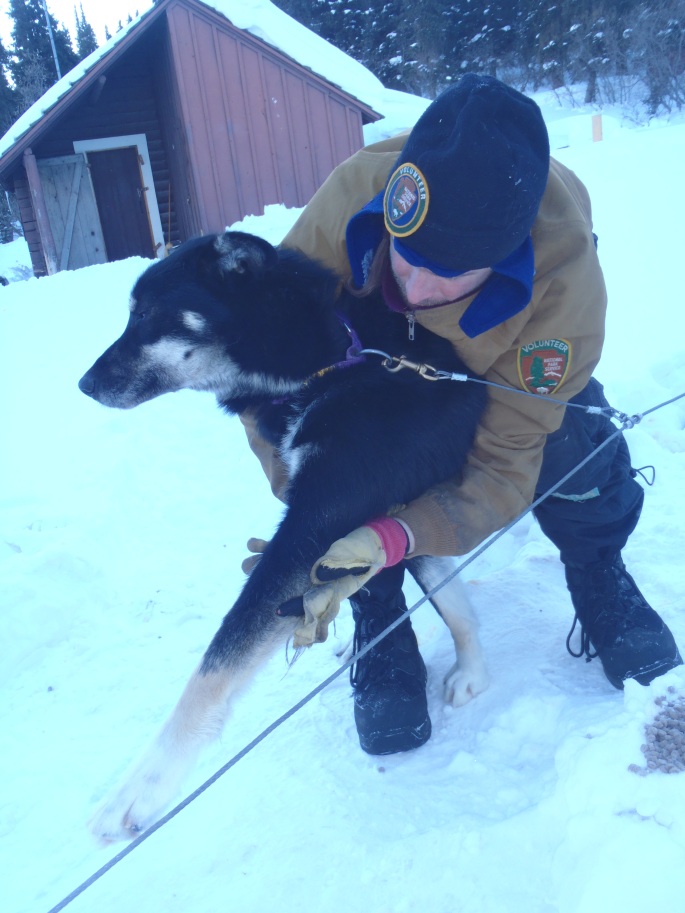As we transition from summer dog sled demonstrations to winter patrols, the work at the kennels changes significantly for both people and dogs; it is training time! While winter kennels staff dusts off the sleds, organizes gear and brushes up on commands, the dogs need to get back into shape mentally and physically.
Before we hook up the dogs to a sled, we must have enough packed snow on the ground so that we can kick a 5 inch snow hook into the snow to securely stop the sled. Until there is sufficient fluffy precipitation, we use ATV's (all terrain vehicles) so that we can train the dogs AND stop the team safely when necessary . We attach a center rope called a gang line to the front of the ATV. The dogs are harnessed and clipped onto the gang line just like they would be if attached to a sled.
We think of our dogs as four-legged, furry athletes; so how do we exercise them before it snows? We break it down into two broad types of exercise we need to accomplish: training and conditioning.
Training includes teaching the dogs commands and challenging them by giving these commands frequently and in unexpected places. The dogs must listen to our commands of turning left (haw) or right (gee) even if we "never go this way". This is also a great time to try younger dogs in the lead position and help reinforce their learning by pairing them with a more experienced lead dog. The best place for us to practice this training is the Riley Creek Campground located two miles from our kennels down the Park Road. Two of the three loops are closed to camping in the winter and with many side access trails, it creates a challenging atmosphere for both musher and dog team.

We also incorporate conditioning into the dogs' exercise routine. Conditioning involves increasing their endurance and strength so that when the snow finally flies, they can break trail and run up to 30 miles a day. A marathon runner starts small and builds up their mileage. We use this same strategy for the dogs by running 3 miles a day when they first start and then increase the mileage each week. We typically drive up to the state lands around Healy when we start to run longer distances to avoid hacing to do too many short loops around the campground. We also have specific strategies for strength. We will start the team from a stopped position and have them pull the ATV in neutral gear for short distances giving them "weight training" to build their slow moving muscles. We also do sprinting intervals to increase their endurance and fast twitch muscle development.

So what other things are important to an athlete in training? Nutrition is very important for these huskies. It is important they receive the appropriate amount of fat and protein in their diet so they can work hard while training and also build muscle. The fat in a dog's diet supplies them with instant energy while they are running and the protein helps them build muscle after they complete their runs. Our dogs are fed a specially formulated high protein, high fat kibble designed to fuel working dogs. In addition to their kibble they get powdered fish meal for added protein, when it is cold or they are running lots of miles they get an additional powdered calorie supplement, when it is really, really cold they get a cube of frozen tri fat blend for extra calories to burn. Some dogs get probiotics to support their digestive systems, older dogs get glucosamine for healthy joints. Feeding our dogs is not a simple kibble in the bowl process. The other major component of feeding a healthy athlete is hydration. We feed dogs a meal in the morning and the evening and with every meal the dog food and supplements are saturated with water so the dogs stay hydrated. While they run, the dogs will often eat bites of snow along the trail otherwise known as "dipping". They have fun doing this and it offers a little hydration, but the bulk of their water comes from their meals. We can't leave bowls of water out for them because they would freeze solid with our winter temperatures.

The last important part to training a happy, healthy sled dog is to make sure they do not have any injuries. Every morning before we run the dogs, we do a health check on each one. This involves looking at long-term issues such as weight and dental care and immediate issues such as sore muscles or splits in their feet. If a dog has a split in one of their feet we will rub an antiseptic ointment into the cut to start the healing process and put a bootie on the foot to protect it from further damage. Sore muscles may involve a before- or after-run doggie massage or some physical therapy to strengthen the surrounding muscle group.
With a balanced exercise regime and a healthy lifestyle for the dogs, we can maximize their quality of life and their performance. One day in mid-November our ATV broke four miles down the trail in Healy. The 10 sled dogs attached to it pulled it right back to our truck in neutral - telling us they were ready for the next phase of training. On November 16 the sleds were brought out and run on the road for the first time this season. Now the dogs are ready, physically and mentally, to patrol the Denali wilderness traditionally!
